Variations of Global Compound Temperature and Precipitation Events and Associated Population Exposure Projected by the CMIP6 Multi-Model Ensemble
Abstract
1. Introduction
2. Materials and Methods
2.1. Source of Data
2.2. Definition of Compound Indices
2.3. Trend Testing and Mutation Analysis
2.4. Global Spatial Autocorrelation Analysis
2.5. Hot Spot and Cold Spot Analysis
2.6. Calculation of Population Exposure
3. Results
3.1. The Temporal Variation Pattern of Compound Extreme Events
3.2. Changes in the Spatial Pattern of Compound Extreme Events
3.3. The Spatial Distribution of Population Exposure under Different Compound Extreme Events
4. Discussion
5. Conclusions
- (1)
- In the future period from 2020 to 2100, there will be a significant downward trend in the warm–wet event, with a decline rate of 0.06 days per decade. Cold–wet events show a significant increasing trend, with an increase rate of 0.06 days per decade. Warm–dry events and cold–dry events show an upward trend, with rates of 0.01 days per decade and 0.02 days per decade, respectively.
- (2)
- West Asia is a hot area where warm–dry events and cold–wet events occur. Northern Africa is a high-risk area for the warm–wet event, while countries such as Brazil in South America are hot spots for the cold–dry event. To address climate risks, regional exchanges and co-operation are necessary.
- (3)
- The intensity of the warm–wet event in the southern hemisphere is higher than that in the northern hemisphere, and the area with the highest number of warm and humid event days is located near a 20 degrees south latitude. The intensity of the cold–wet event is higher in the northern hemisphere than in the southern hemisphere. The intensity of the warm–dry event in the northern hemisphere is higher than that in the southern hemisphere. The intensity of the cold–dry event is strongest near a 60 degrees north and south latitude.
- (4)
- East Asia, South Asia, and central Africa have higher levels of population exposure globally than other regions. Areas with medium (105 person · day) or higher population exposure levels for warm–wet and cold–wet events both account for approximately 13% of the total area, while warm–dry and cold- dry events account for 25% and 19% of the total area, respectively.
Author Contributions
Funding
Data Availability Statement
Conflicts of Interest
References
- Mazdiyasni, O.; AghaKouchak, A.; Davis, S.J.; Madadgar, S.; Mehran, A.; Ragno, E.; Sadegh, M.; Sengupta, A.; Ghosh, S.; Dhanya, C.T.; et al. Increasing probability of mortality during Indian heat waves. Sci. Adv. 2017, 3, e1700066. [Google Scholar] [CrossRef] [PubMed]
- Gu, X.; Zhang, Q.; Li, J.; Singh, V.P.; Liu, J.; Sun, P.; Cheng, C. Attribution of global soil moisture drying to human activities: A quantitative viewpoint. Geophys. Res. Lett. 2019, 46, 2573–2582. [Google Scholar] [CrossRef]
- Satoh, Y.; Yoshimura, K.; Pokhrel, Y.; Kim, H.; Shiogama, H.; Yokohata, T.; Hanasaki, N.; Wada, Y.; Burek, P.; Byers, E.; et al. The timing of unprecedented hydrological drought under climate change. Nat. Commun. 2022, 13, 3287. [Google Scholar] [CrossRef]
- Li, C.; Gu, X.; Slater, L.J.; Liu, J.; Li, J.; Zhang, X.; Kong, D. Urbanization-Induced Increases in Heavy Precipitation are Magnified by Moist Heatwaves in an Urban Agglomeration of East China. J. Clim. 2023, 36, 693–709. [Google Scholar] [CrossRef]
- Fouillet, A.; Rey, G.; Laurent, F.; Pavillon, G. Excess mortality related to the August 2003 heat wave in France. Int. Arch. Occup. Environ. Health 2006, 80, 16–24. [Google Scholar] [CrossRef] [PubMed]
- Sun, X.; Sun, Q.; Zhou, X.; Li, X.; Yang, M.; Yu, A.; Geng, F. Heat wave impact on mortality in Pudong New Area, China in 2013. Sci. Total Environ. 2014, 493, 789–794. [Google Scholar] [CrossRef] [PubMed]
- Van Oldenborgh, G. Rapid Attribution of the Extreme Rainfall in Texas from Tropical Storm Imelda. 2019. Available online: https://www.worldweatherattribution.org/rapid-attribution-of-the-extreme-rainfall-in-texas-from-tropical-storm-imelda/ (accessed on 1 September 2023).
- Ridder, N.; Pitman, A.; Westra, S.; Ukkola, A.; Hong, X.; Bador, M.; Hirsch, A.L.; Evans, J.; Di Luca, A.; Zscheischler, J. Global hotspots for the occurrence of compound events. Nat. Commun. 2020, 11, 5956. [Google Scholar] [CrossRef] [PubMed]
- Zhang, P.; Jeong, J.-H.; Yoon, J.-H.; Kim, H.; Wang, S.; Linderholm, H.W.; Fang, K.; Wu, X.; Chen, D. Abrupt shift to hotter and drier climate over inner East Asia beyond the tipping point. Science 2020, 370, 1095–1099. [Google Scholar] [CrossRef]
- Guan, Y.; Gu, X.; Slater, L.; Li, L.; Kong, D.; Liu, J.; Zhang, X.; Yan, X. Tracing anomalies in moisture recycling and transport to two record-breaking droughts over the Mid-to-Lower Reaches of the Yangtze River. J. Hydrol. 2022, 609, 127787. [Google Scholar] [CrossRef]
- Yu, X.; Gu, X.; Kong, D.; Zhang, Q.; Cao, Q.; Slater, L.J.; Ren, G.; Luo, M.; Li, J.; Liu, J.; et al. Asymmetrical shift toward less light and more heavy precipitation in an urban agglomeration of East China: Intensification by urbanization. Geophys. Res. Lett. 2022, 49, e2021GL097046. [Google Scholar] [CrossRef]
- Zscheischler, J.; Seneviratne, S.I. Dependence of drivers affects risks associated with compound events. Sci. Adv. 2017, 3, e1700263. [Google Scholar] [CrossRef] [PubMed]
- Sarhadi, A.; Ausín, M.C.; Wiper, M.P.; Touma, D.; Diffenbaugh, N.S. Multidimensional risk in a nonstationary climate: Joint probability of increasingly severe warm and dry conditions. Sci. Adv. 2018, 4, aau3487. [Google Scholar] [CrossRef]
- Willett, K.M.; Sherwood, S. Exceedance of heat index thresholds for 15 regions under a warming climate using the Wet-Bulb Globe temperature. Int. J. Climatol. 2012, 32, 161–177. [Google Scholar] [CrossRef]
- Schwingshackl, C.; Sillmann, J.; Vicedo-Cabrera, A.M.; Sandstad, M.; Aunan, K. Heat stress indicators in CMIP6: Estimating future trends and exceedances of impact-relevant thresholds. Earths Future 2021, 9, e2020EF001885. [Google Scholar] [CrossRef]
- Barriopedro, D.; Fischer, E.M.; Luterbacher, J.; Trigo, R.M.; GarcíaHerrera, R. The hot summer of 2010: Redrawing the temperature record map of Europe. Science 2011, 332, 220–224. [Google Scholar] [CrossRef]
- Grumm, R.H. The central European and Russian heat event of July–August 2010. Bull. Am. Meteorol. 2011, 92, 1285–1296. [Google Scholar] [CrossRef]
- Witte, J.C.; Douglass, A.R.; da Silva, A.; Torres, O.; Levy, R.; Duncan, B.N. NASA A-Train and Terra observations of the 2010 Russian wildfires. Atmos. Chem. Phys. 2011, 11, 9287–9301. [Google Scholar] [CrossRef]
- Hauser, M.; Orth, R.; Seneviratne, S.I. Role of soil moisture versus recent climate change for the 2010 heat wave in western Russia. Geophys. Res. Lett. 2016, 43, 2819–2826. [Google Scholar] [CrossRef]
- IPCC. Summary for Policymakers, Climate Change 2021: The Physical Science Basis; Cambridge University Press: Cambridge, UK, 2021; pp. 3–32. [Google Scholar]
- Wu, X.; Hao, Z.; Hao, F.; Zhang, X. Variations of compound precipitation and temperature extremes in China during 1961–2014. Sci. Total Environ. 2019, 663, 731–737. [Google Scholar] [CrossRef]
- Ciais, P.; Reichstein, M.; Viovy, N.; Granier, A.; Ogée, J.; Allard, V.; Aubinet, M.; Buchmann, N.; Bernhofer, C.; Carrara, A.; et al. Europe-wide reduction in primary productivity caused by the heat and drought in 2003. Nature 2005, 437, 529–533. [Google Scholar] [CrossRef]
- Allen, C.D.; Macalady, A.K.; Chenchouni, H.; Bachelet, D.; McDowell, N.; Vennetier, M.; Kitzberger, T.; Rigling, A.; Breshears, D.D.; Hogg, E.H.; et al. A global overview of drought and heat-induced tree mortality reveals emerging climate change risks for forests. For. Ecol. Manag. 2010, 259, 660–684. [Google Scholar] [CrossRef]
- Bandyopadhyay, S.; Kanji, S.; Wang, L. The impact of rainfall and temperature variation on diarrheal prevalence in sub-Saharan Africa. Appl. Geogr. 2012, 33, 63–72. [Google Scholar] [CrossRef]
- Schmidli, J.; Frei, C. Trends of heavy precipitation and wet and dry spells in Switzerland during the 20th century. Int. J. Climatol. 2005, 25, 753–771. [Google Scholar] [CrossRef]
- Benestad, R.E.; Haugen, J.E. On complex extremes: Flood hazards and combined high spring-time precipitation and temperature in Norway. Clim. Chang. 2007, 85, 381–406. [Google Scholar] [CrossRef]
- Eyring, V.; Bony, S.; Meehl, G.A.; Senior, C.A.; Stevens, B.; Stouffer, R.J.; Taylor, K.E. Overview of the coupled model intercomparison project phase 6 (CMIP6) experimental design and organization. Geosci. Model Dev. 2016, 9, 1937–1958. [Google Scholar] [CrossRef]
- Stouffer, R.J.; Eyring, V.; Meehl, G.A.; Bony, S.; Senior, C.; Stevens, B.; Taylor, K.E. CMIP5 scientific gaps and recommendations for CMIP6. Bull. Am. Meteorol. 2017, 98, 95–105. [Google Scholar] [CrossRef]
- Rohat, G.; Flacke, J.; Dosio, A.; Dao, H.; van Maarseveen, M. Projections of human exposure to dangerous heat in African cities under multiple socioeconomic and climate scenarios. Earths Future 2019, 7, 528–546. [Google Scholar] [CrossRef]
- Riahi, K.; van Vuuren, D.P.; Kriegler, E.; Edmonds, J.; O’Neill, B.C.; Fujimori, S.; Bauer, N.; Calvin, K.; Dellink, R.; Fricko, O.; et al. The shared socioeconomic pathways and their energy, land use, and greenhouse gas emissions implications: An overview. Glob. Environ. Chang. 2017, 42, 153–168. [Google Scholar] [CrossRef]
- Beniston, M. Trends in joint quantiles of temperature and precipitation in Europe since 1901 and projected for 2100. Geophys. Res. Lett. 2009, 36, L07707. [Google Scholar] [CrossRef]
- Hao, Z.; AghaKouchak, A.; Phillips, T.J. Changes in concurrent monthly precipitation and temperature extremes. Environ. Res. Lett. 2013, 8, 034014. [Google Scholar] [CrossRef]
- Yue, S.; Pilon, P.; Cavadias, G. Power of the Mann-Kendall and Spearman’s rho tests for detecting monotonic trends in hydrological series. J. Hydrol. 2002, 259, 254–271. [Google Scholar] [CrossRef]
- Gocic, M.; Trajkovic, S. Analysis of changes in meteorological variables using Mann–Kendall and Sen’s slope estimator statistical tests in Serbia. Glob. Planet Chang. 2013, 100, 172–182. [Google Scholar] [CrossRef]
- Mann, H. Nonparametric test against trend. Econometrica 1945, 13, 245–259. [Google Scholar] [CrossRef]
- Kendall, M. Rank Correlation Methods. 1948. Available online: https://psycnet.apa.org/record/1948-15040-000 (accessed on 11 September 2023).
- Thompson, E.; Saveyn, P.; Declercq, M.; Meert, J.; Guida, V.; Eads, C.D.; Robles, E.S.J.; Britton, M.M. Characterisation of heterogeneity and spatial autocorrelation in phase separating mixtures using Moran’s I. J. Colloid Interface Sci. 2018, 513, 180–187. [Google Scholar] [CrossRef] [PubMed]
- Zhang, T.; Lin, G. On Moran’s I coefficient under heterogeneity. Comput. Stat. Data Ann. 2016, 95, 83–94. [Google Scholar] [CrossRef]
- Cliff, A.D.; Ord, J.K. Spatial Processes: Models and Applications; Pion Limited: London, UK, 1981. [Google Scholar]
- Getis, A.; Ord, J.K. The analysis of spatial association by use of distance statistics. Geogr. Anal. 1992, 24, 189–206. [Google Scholar] [CrossRef]
- Streletskiy, D.A.; Sherstiukov, A.B.; Frauenfeld, O.W.; Nelson, F.E. Changes in the 1963–2013 shallow ground thermal regime in Russian permafrost regions. Environ. Res. Lett. 2015, 10, 125005. [Google Scholar] [CrossRef]
- Liu, D.; Zhao, Q.; Guo, S.; Liu, P.; Xiong, L.; Yu, X.; Zou, H.; Zeng, Y.; Wang, Z. Variability of spatial patterns of autocorrelation and heterogeneity embedded in precipitation. Hydrol. Res. 2019, 50, 215–230. [Google Scholar] [CrossRef]
- Jones, B.; O’Neill, B.C.; McDaniel, L. Future population exposure to US heat extremes. Nat. Clim. Chang. 2015, 5, 652–655. [Google Scholar] [CrossRef]
- Jones, B.; O’Neill, B.C. Spatially explicit global population scenarios consistent with the Shared Socioeconomic Pathways. Environ. Res. Lett. 2016, 11, 084003. [Google Scholar] [CrossRef]
- Zhang, G.; Wang, H.; Gan, T.; Zhang, S.; Shi, L.; Zhao, J.; Su, X.; Song, S. Climate Change Determines Future Population Exposure to Summertime Compound Dry and Hot Events. Earths Future 2022, 10, e2022EF003015. [Google Scholar] [CrossRef]
- Li, D.; Yuan, J.; Kopp, R.E. Escalating global exposure to compound heat-humidity extremes with warming. Environ. Res. Lett. 2020, 15, 064003. [Google Scholar] [CrossRef]
- Hao, Z.; Hao, F.; Singh, V.P.; Zhang, X. Changes in the severity of compound drought and hot extremes over global land areas. Environ. Res. Lett. 2018, 13, 124022. [Google Scholar] [CrossRef]
- Herrera-Estrada, J.E.; Sheffield, J. Uncertainties in future projections of summer droughts and heat waves over the contiguous United States. J. Clim. 2017, 30, 6225–6246. [Google Scholar] [CrossRef]
- Schubert, S.D.; Wang, H.; Koster, R.D.; Suarez, M.J.; Groisman, P.Y. Northern Eurasian heat waves and droughts. J. Clim. 2014, 27, 3169–3207. [Google Scholar] [CrossRef]
- Pietrucha, K.; Tchórzewska, B. Water Supply System operation regarding consumer safety using Kohonen neural network. In Safety, Reliability and Risk Analysis: Beyond the Horizon; CRC Press: Boca Raton, FL, USA, 2014; pp. 1115–1120. [Google Scholar]
- Janusz, R.; Barbara, T.; Katarzyna, P. A Hazard Assessment Method for Waterworks Systems Operating in Self-Government Units. Int. J. Environ. Res. Public Health 2019, 16, 767. [Google Scholar] [CrossRef]

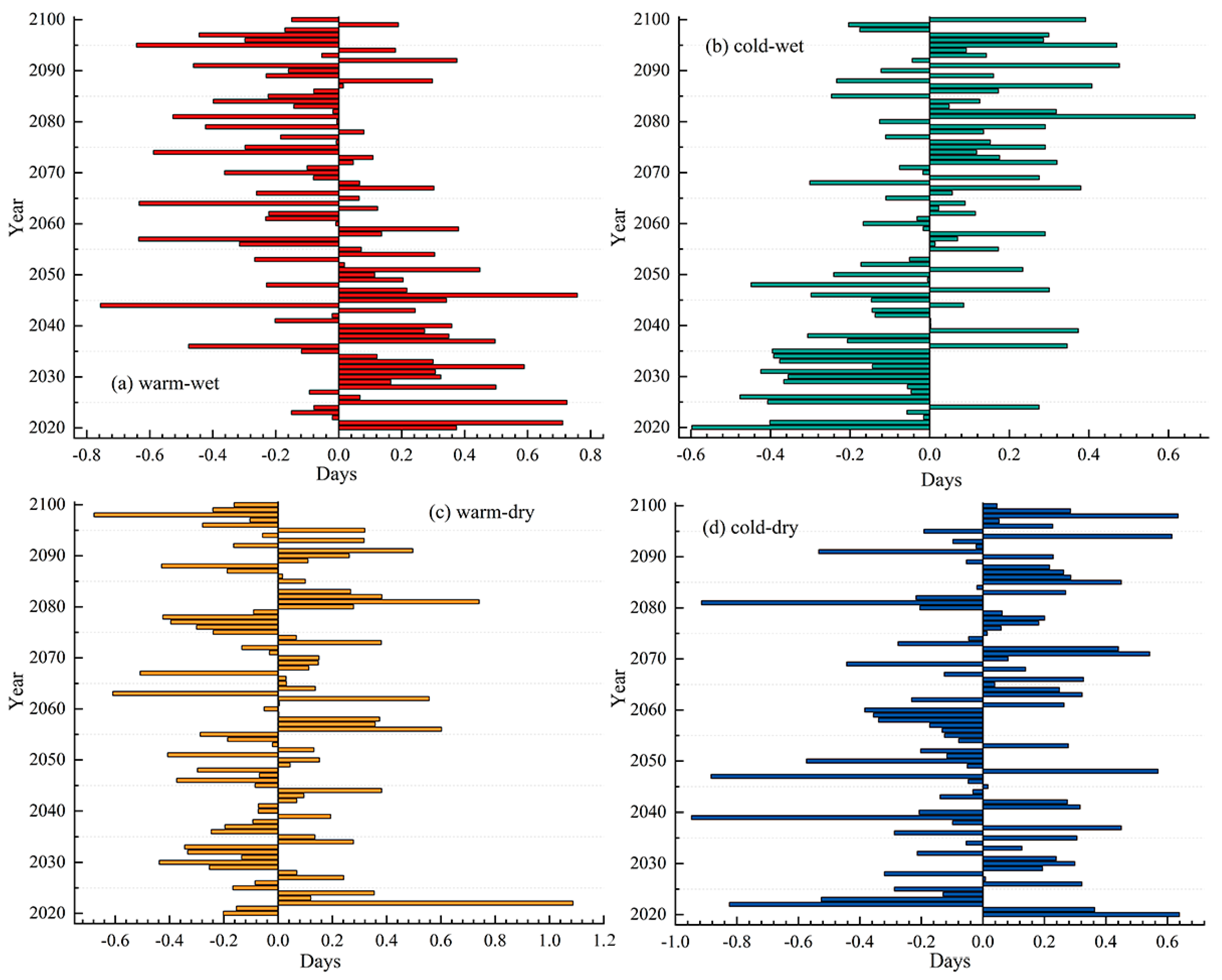
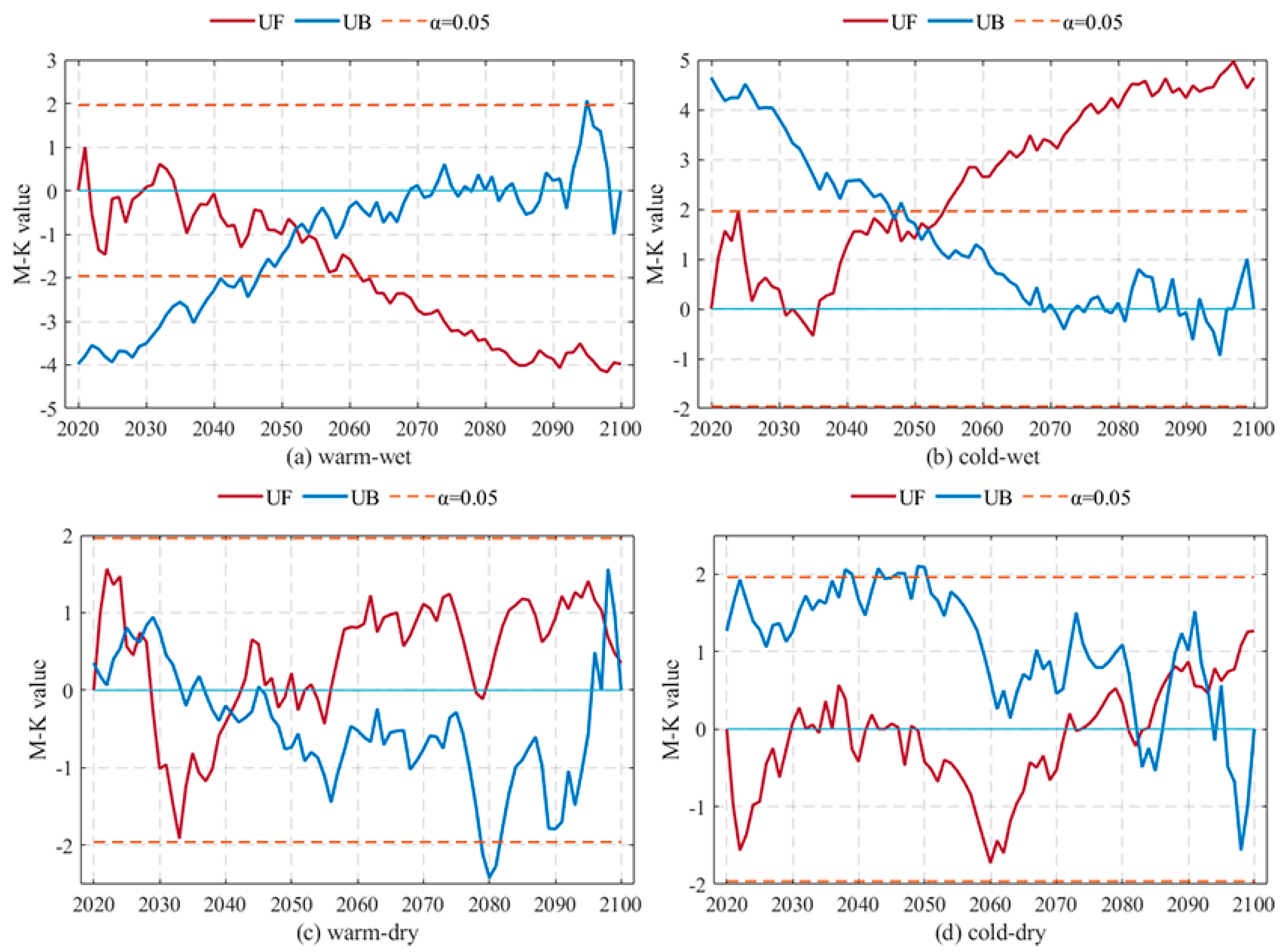
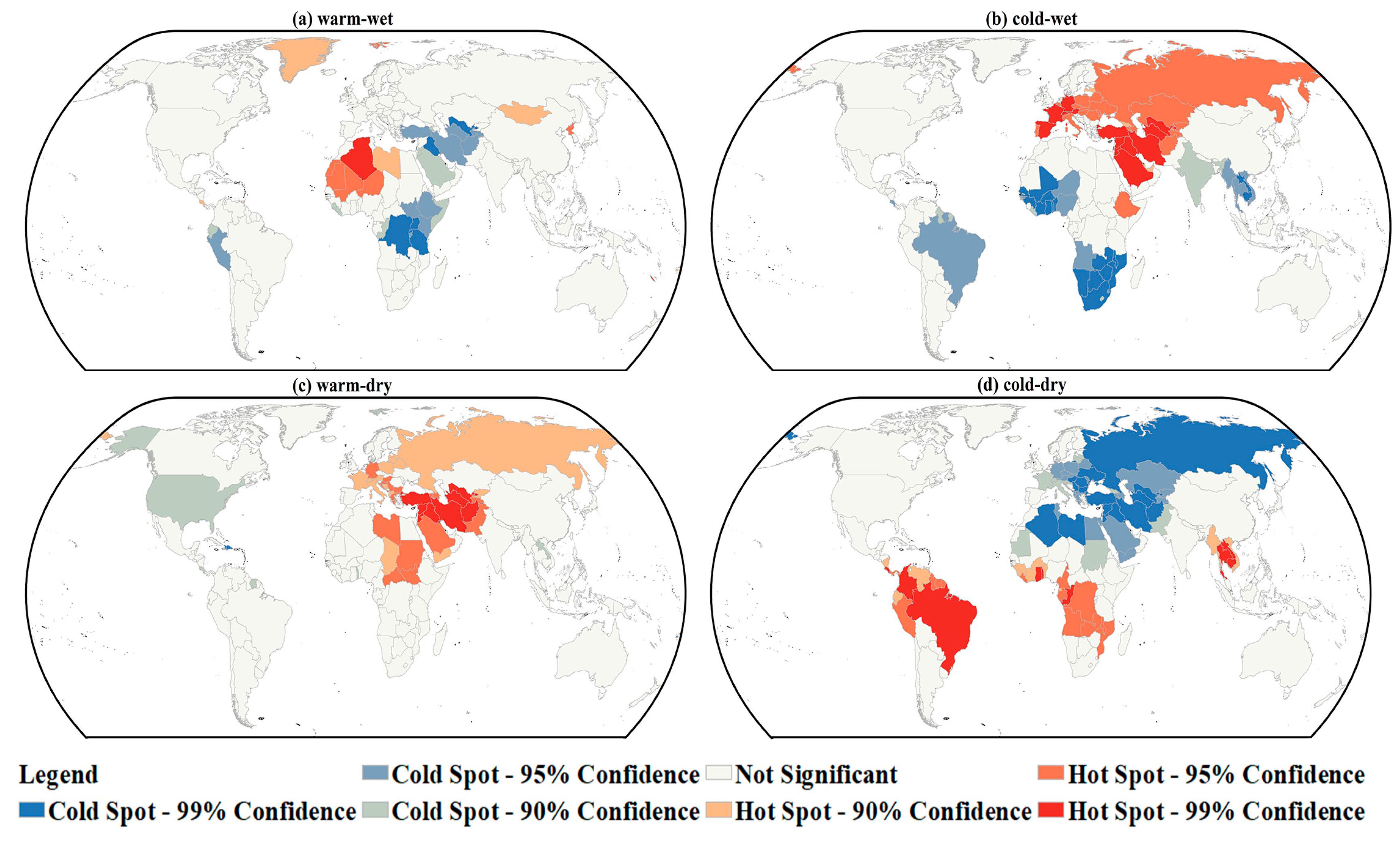

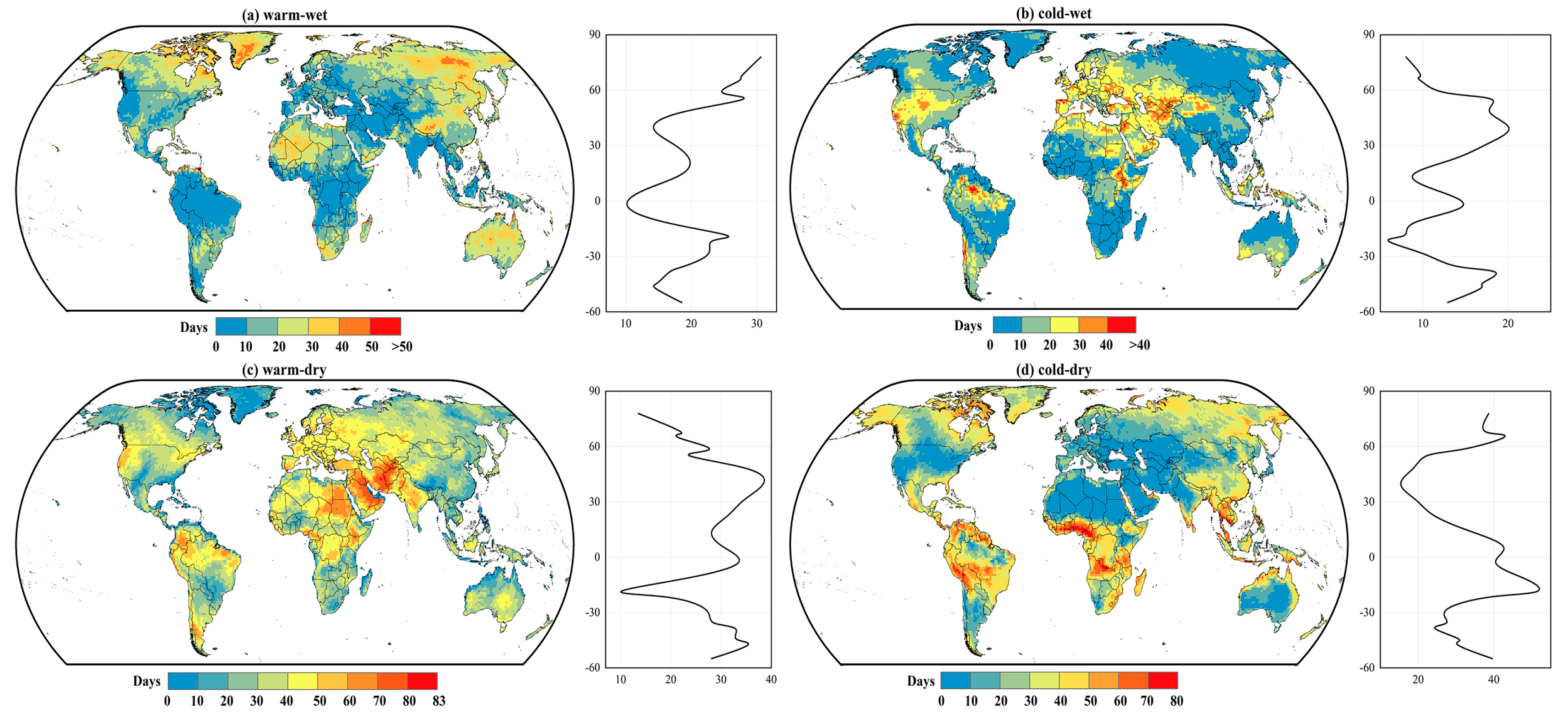
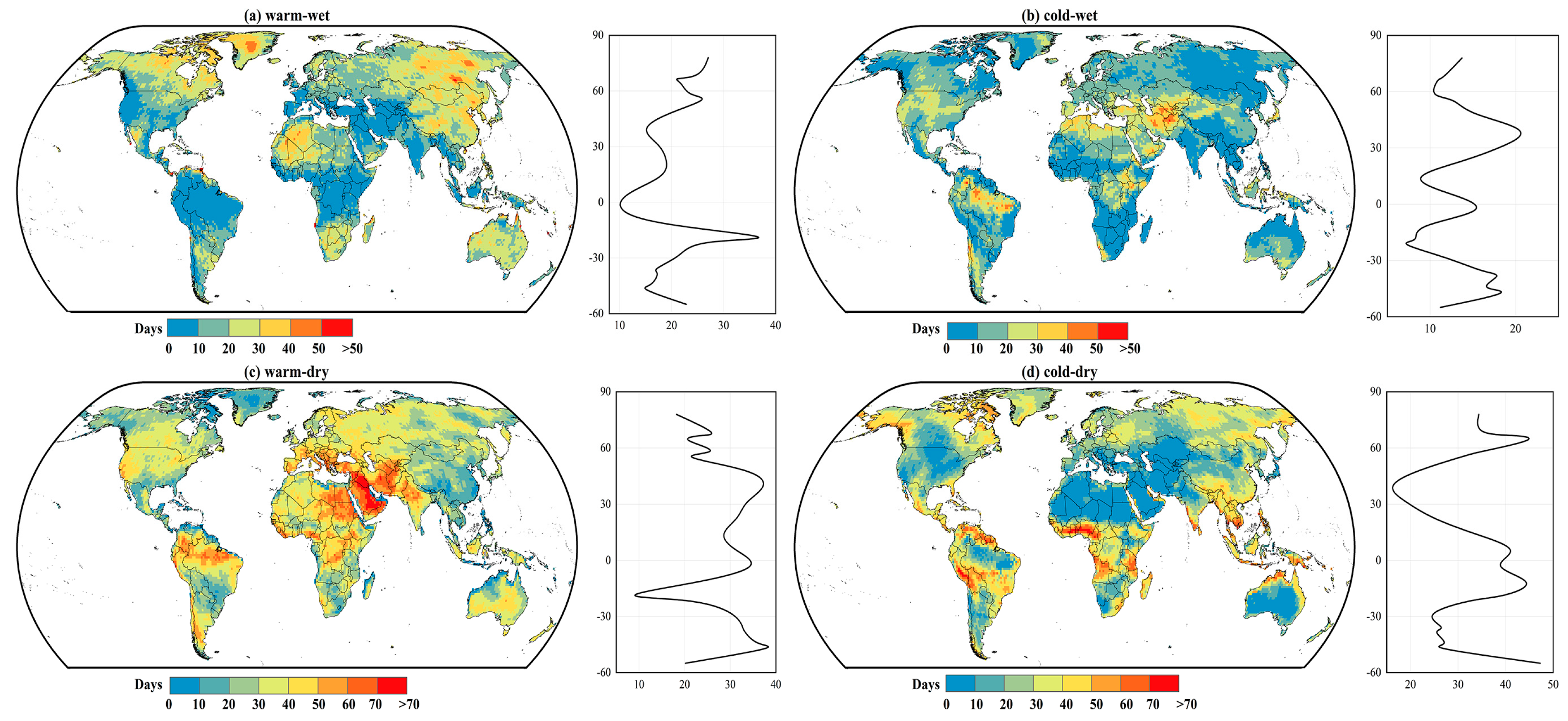
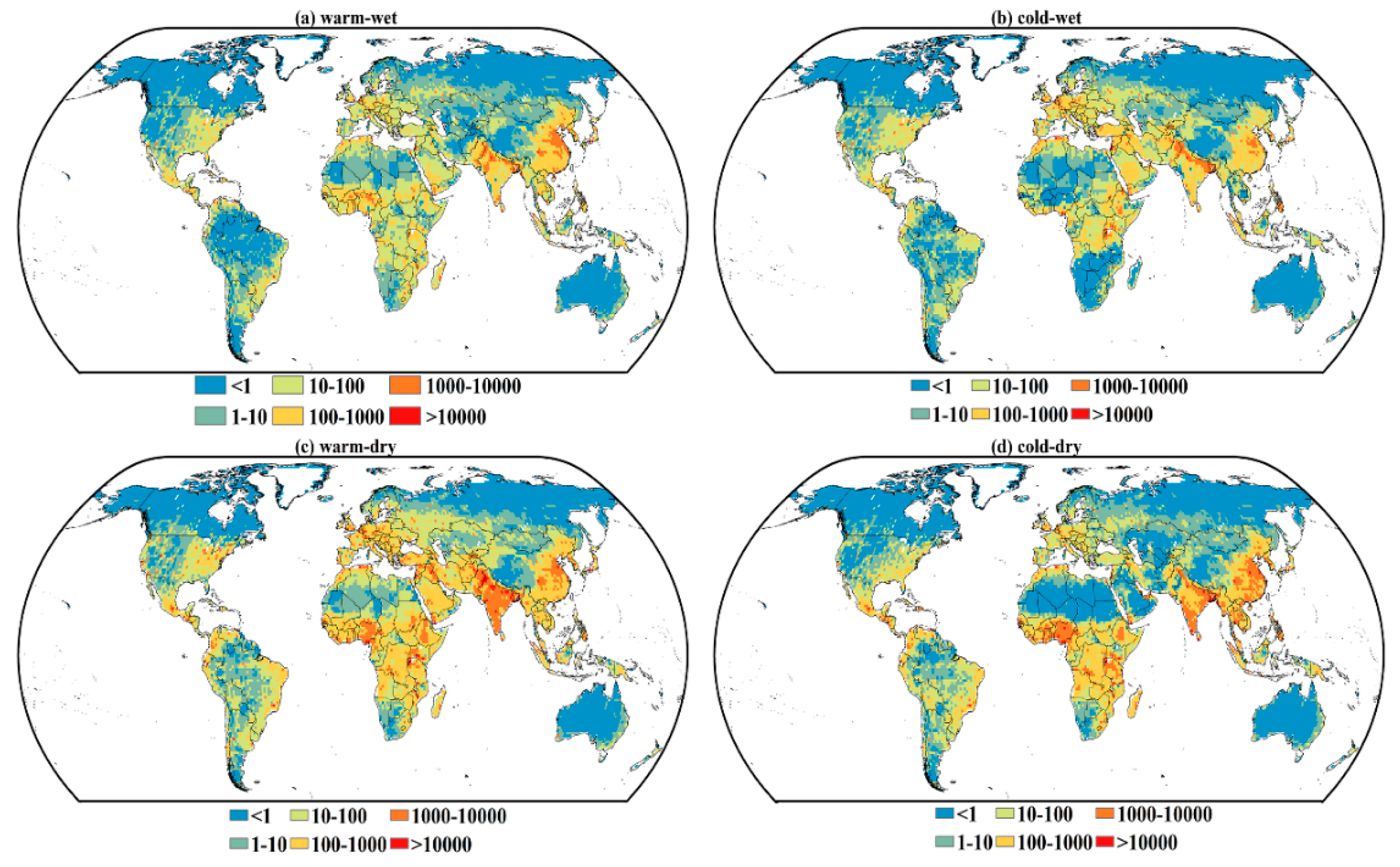
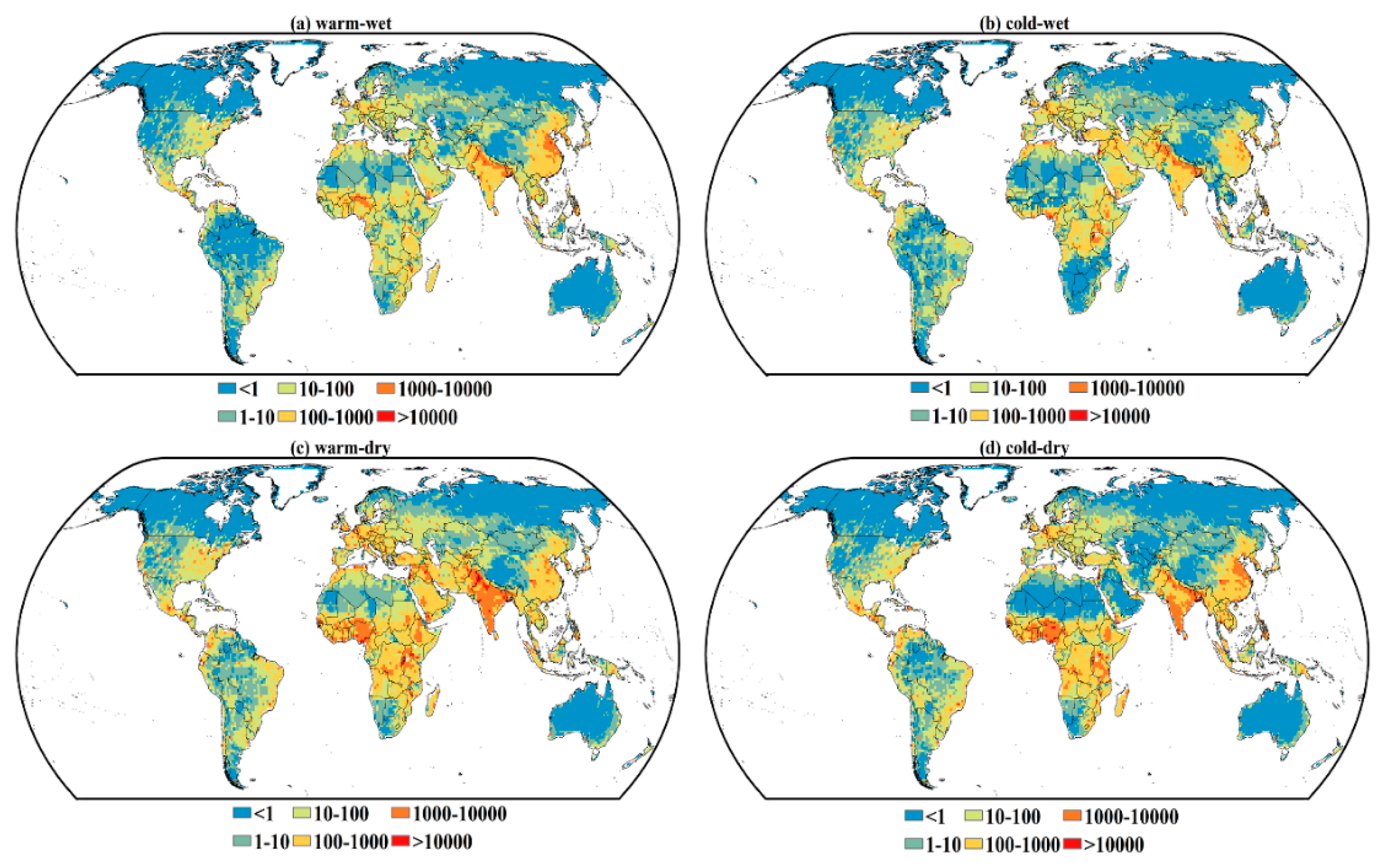
| Number | Name | Country | Original Resolution |
|---|---|---|---|
| 1 | GFDL-ESM4 | USA | 1° × 1.25° |
| 2 | UKESM1-0-LL | UK | 1.875° × 1.25° |
| 3 | MPI-ESM1-2-HR | Germany | 0.93° × 0.94° |
| 4 | IPSL-CM6A-LR | France | 1.27° × 2.5° |
| 5 | MRI-ESM2-0 | Japan | 1.125° × 1.125° |
| Name | Definition | Units |
|---|---|---|
| warm–wet | Tmax > T75 & P > P75 | d |
| warm–dry | Tmax > T75 & P < P25 | d |
| cold–wet | Tmin < T25 & P > P75 | d |
| cold–dry | Tmin < T25 & P < P25 | d |
| Warm–Wet | Cold–Wet | Warm–Dry | Cold–Dry | |
|---|---|---|---|---|
| z | −3.98 | 4.64 | 0.35 | 1.26 |
| p | <0.01 | <0.01 | 0.72 | 0.21 |
| slope | −0.006 | 0.006 | 0.001 | 0.002 |
| 2020 | 2030 | 2040 | 2050 | 2060 | 2070 | 2080 | 2090 | 2100 | ||
|---|---|---|---|---|---|---|---|---|---|---|
| warm–wet | Moran’s I | 0.34 | 0.35 | 0.38 | 0.4 | 0.36 | 0.38 | 0.36 | 0.28 | 0.41 |
| Z | 6.14 | 6.26 | 6.89 | 7.22 | 6.08 | 6.83 | 6.47 | 5.12 | 7.46 | |
| p | 0 | 0 | 0 | 0 | 0 | 0 | 0 | 0 | 0 | |
| cold–wet | Moran’s I | 0.78 | 0.75 | 0.76 | 0.8 | 0.73 | 0.76 | 0.74 | 0.66 | 0.71 |
| Z | 13.89 | 13.21 | 13.46 | 14.25 | 12.84 | 13.38 | 13.13 | 11.62 | 12.54 | |
| p | 0 | 0 | 0 | 0 | 0 | 0 | 0 | 0 | 0 | |
| warm–dry | Moran’s I | 0.38 | 0.45 | 0.46 | 0.48 | 0.46 | 0.5 | 0.43 | 0.45 | 0.53 |
| Z | 6.82 | 8.05 | 8.19 | 8.49 | 8.22 | 8.83 | 7.73 | 7.96 | 9.37 | |
| p | 0 | 0 | 0 | 0 | 0 | 0 | 0 | 0 | 0 | |
| cold–dry | Moran’s I | 0.68 | 0.7 | 0.67 | 0.7 | 0.71 | 0.73 | 0.65 | 0.66 | 0.64 |
| Z | 11.97 | 12.37 | 11.94 | 12.41 | 12.58 | 12.83 | 11.59 | 11.69 | 11.35 | |
| p | 0 | 0 | 0 | 0 | 0 | 0 | 0 | 0 | 0 |
Disclaimer/Publisher’s Note: The statements, opinions and data contained in all publications are solely those of the individual author(s) and contributor(s) and not of MDPI and/or the editor(s). MDPI and/or the editor(s) disclaim responsibility for any injury to people or property resulting from any ideas, methods, instructions or products referred to in the content. |
© 2024 by the authors. Licensee MDPI, Basel, Switzerland. This article is an open access article distributed under the terms and conditions of the Creative Commons Attribution (CC BY) license (https://creativecommons.org/licenses/by/4.0/).
Share and Cite
Yang, Y.; Yue, T. Variations of Global Compound Temperature and Precipitation Events and Associated Population Exposure Projected by the CMIP6 Multi-Model Ensemble. Sustainability 2024, 16, 5007. https://doi.org/10.3390/su16125007
Yang Y, Yue T. Variations of Global Compound Temperature and Precipitation Events and Associated Population Exposure Projected by the CMIP6 Multi-Model Ensemble. Sustainability. 2024; 16(12):5007. https://doi.org/10.3390/su16125007
Chicago/Turabian StyleYang, Yang, and Tianxiang Yue. 2024. "Variations of Global Compound Temperature and Precipitation Events and Associated Population Exposure Projected by the CMIP6 Multi-Model Ensemble" Sustainability 16, no. 12: 5007. https://doi.org/10.3390/su16125007
APA StyleYang, Y., & Yue, T. (2024). Variations of Global Compound Temperature and Precipitation Events and Associated Population Exposure Projected by the CMIP6 Multi-Model Ensemble. Sustainability, 16(12), 5007. https://doi.org/10.3390/su16125007







